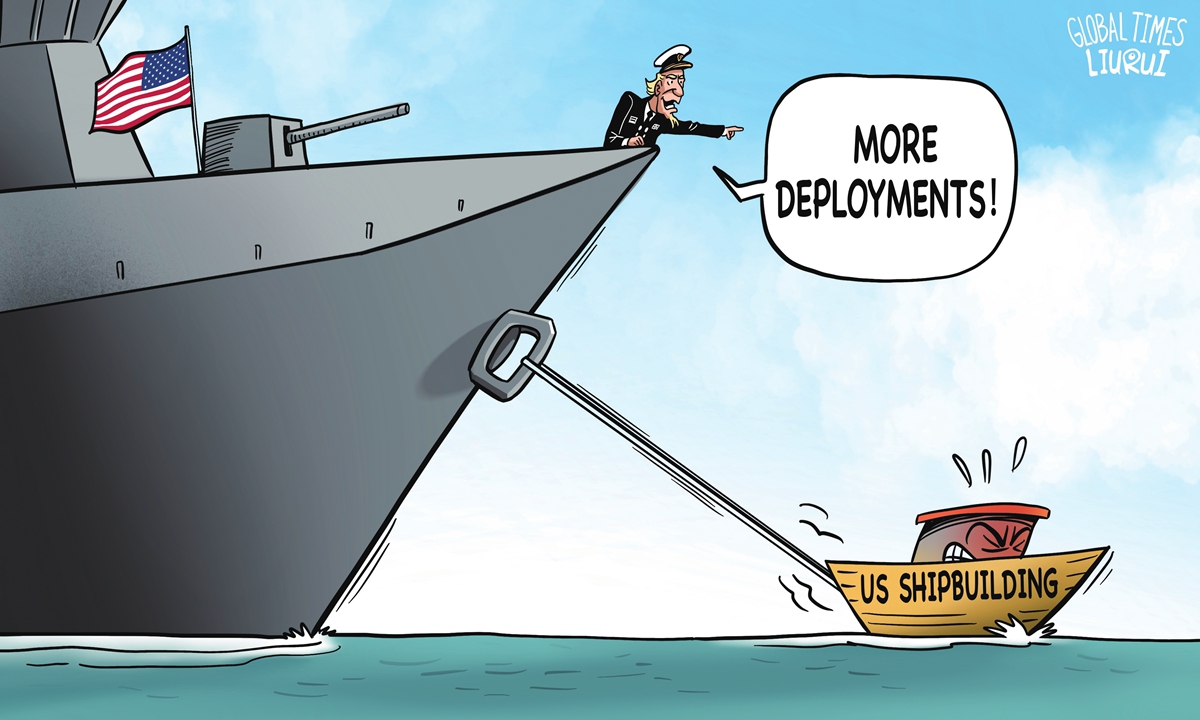
Illustration: Liu Rui/GT
In order to contain China, the US must maintain military and economic primacy over China. Nevertheless, its ability to do this has come into question in recent years due to the continual rise and growing strength of China, and the demonstrated growing weakness of the US itself.
Among these weaknesses is the US' atrophying military industrial base, in particular its capacity to build the ships, warplanes and missiles required to exceed Chinese military power off China's own coasts.
The Associated Press in a recent article pointed out that the US Navy's warship production is in its worst state in 25 years, stating that this has put the country "behind China in the number of ships at its disposal - and the gap is widening." The article describes a critical labor shortage and a shrinking shipbuilding capacity that has increased over decades of neglect and mismanagement.
This reflects a much wider workforce crisis across the country's military-industrial base as reported in the 2023 US National Defense Industrial Strategy report, which stated that the labor market lacks sufficient workers with the right skills to meet domestic production and sustainment demand.
For the US, with around a quarter of the population of China, sufficiently expanding its education system and its ability to produce sufficient skilled laborers to compete with China is impractical. This reflects the equally impractical nature of US foreign policy and its desire to maintain primacy over China.
Many in the US arms industry believe that despite these disadvantages, the US can still find ways to "out-innovate" China. An example of this is the startup arms manufacturer Anduril and its "Arsenal" concept. Anduril aims to address the urgent needs of the US and its allies and prevent a situation in which "the US military would run out of weapons in less than one week of a war with China" by simplifying the design of US weapons, incorporating more off-the-shelf components already commercially available, and utilizing emerging industrial practices like "software-defined manufacturing" (SDM). It also resorts to mass-producing naval drones of various classes and sizes.
The problem for Anduril and its prospective customers at the Pentagon is that any manufacturing process Anduril develops to compete with China, China will have the ability to match due to its many other fundamental advantages in industrial production.
According to Defense One in a February 2024 article, overall China's navy has more ships than the US including 30 ships it built in the past year. Over the same period of time, the US built only two ships. If this is true, the idea that the US can somehow expand shipbuilding by over 15 times is fantasy.
It is also a fantasy to imagine the US can make up for this large and growing gap in shipbuilding by producing naval drones with software-defined manufacturing, as US-based Anduril proposes, considering China's advantages in production, including the use of SDM and the production of drones.
The US geopolitical reach exceeds its industrial grasp due to the flawed premise on which its foreign policy is based. The belief in the US' inherent superiority over all other nations has led to the myth that US hegemony over the world is sustainable and should be maintained.
However, this dominance was not due to inherent superiority, but rather a vast disparity in terms of economic, technological and military power. The story of the 20th and 21st centuries is one of narrowing disparity. The story of tomorrow will be of this disparity growing once again, but in favor of the global majority of which China is a key player.
For the US, there is only one rational course of action to address the reality of Western hegemony having run its course, with a multipolar world taking its place. The US must find a constructive role to play among all other nations rather than continuing to irrationally attempt to impose itself upon all other nations.
In the meantime, the US arms industry, including shipbuilding, will continue consuming huge amounts of public money at the expense of essential American infrastructure and education, both ironically essential factors in bolstering industrial production.
At the same time, both the American and Chinese public face a potential war as Washington continues ratcheting up tensions in the Asia-Pacific region - an unnecessary war the US is unprepared to fight and unlikely to win.
The author is a geopolitical analyst and a former soldier of US Marine Corps. opinion@globaltimes.com.cn




